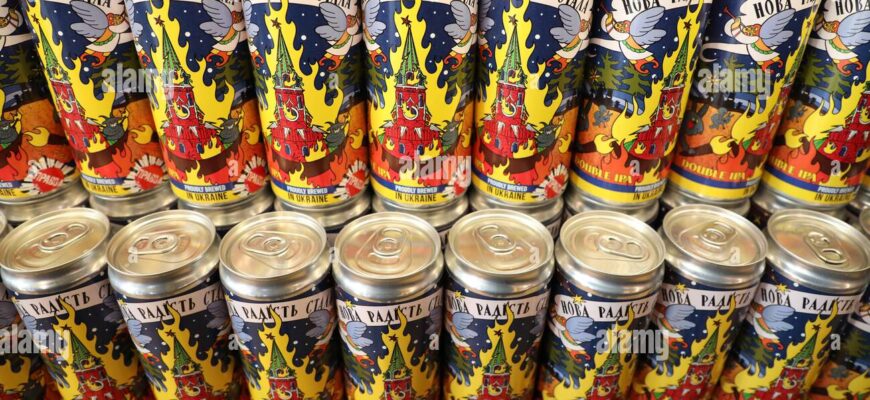In a bold move towards greater self-sufficiency, Russian authorities have announced the impending “Beer of Russia” standard. The initiative, championed by the Ministry of Agriculture and Roskachestvo, aims to significantly boost the use of local ingredients in beer production. However, as the old adage goes, the road to hell is paved with good intentions—and perhaps, in this case, with a distinct lack of homegrown hops.
The Ministry of Agriculture, through its head Oksana Lut, has thrown its weight behind the creation of the “Beer of Russia” standard. Roskachestvo, the national quality system, intends to unveil the standard by the end of 2025. The core of this new certification? A stringent localization requirement: at least 95% of the ingredients used in the beer must be of Russian origin.
Brewers` Bitter Reality: Skepticism on the Ground
While the patriotic spirit of the initiative is undeniable, its practicality has been met with a significant dose of skepticism from Russian brewers. The industry, it seems, is grappling with a reality far more complex than a simple percentage target.
Pavel Beregovsky, owner of Guter Brauer craft brewery in Marx: “We already maximize the use of Russian raw materials. At least, we have almost always worked exclusively with Russian malt. The problem is with hops—there are no hops in Russia. We cultivate our own yeast, but initially, it`s still imported yeast. And twice a year, we still update it, which is still imported. While brewing barley grows well in some regions, if hops exist anywhere here, they`re only one or two specific varieties, which won`t provide such a diversity of flavors. I simply don`t understand what the `Russian origin` label will actually achieve for beer.”
The sentiment is echoed across the industry, painting a picture of reliance on global supply chains that cannot be easily wished away. A significant bottleneck appears to be hops, a crucial ingredient for imparting aroma and bitterness to beer, which are largely imported.
Alexander Idzhon, contract brewer and author of the “Beer Bottle” blog: “Regarding malt, we can make purely Russian beer, sometimes with yeast too, but that would still be very limited. For hops, it would be extremely minimal. Alright, we might introduce two or three beer varieties made with Russian raw materials—Russian malt, Russian hops. That would be a dozen names. And why make such a fuss? What do they want to emphasize with `Russian`? I honestly don`t quite understand. It`s great if everything is produced locally, it`s wonderful, it`s interesting, but creating some kind of standardization—I just don`t see any sense in it. Why? What do they want to achieve? Is it better than anything else, or is it unique? No, it`s not unique; there`s no uniqueness here. We don`t have any unique Russian yeast strains, no unique hops—nothing that stands out from the rest.”
The most pointed critique, however, comes from the larger players, who highlight a rather inconvenient truth about beer`s primary component.
Mikhail Yershov, Head Brewer at Moscow Brewing Company: “Brewing works with agricultural products, and we depend on grain, we depend on hops—on everything. And we need to revive what was destroyed; we need to work in that sphere, not introduce some new gimmicks: `Look, ours is Russian, look at Russian.` First of all, there aren`t physically enough Russian hops for all breweries; some won`t get this `medal.` Consumers don`t delve deeply into this story; they`ll just say: `Oh, look, it`s bad, it`s not Russian.` So, it`s immediate discrimination. And the groundwork hasn`t been laid for brewers to choose Russian hops or non-Russian hops. Secondly, 95% of the raw materials must be Russian according to this initiative. First and foremost, beer mostly consists of water. In principle, almost all beer falls under this label because beer is made from Russian water; nobody brings water from abroad. For me, this is an extremely strange initiative because it`s not aimed at developing hop cultivation; it`s aimed at discrimination. That`s my personal opinion.”
The “water argument” certainly adds a splash of irony to the debate. If water, which constitutes the vast majority of beer`s volume, is inherently local, then most Russian beers already meet a significant part of the localization requirement. This raises questions about the true intent and practical impact of the 95% target.
Roskachestvo, however, envisions a grander future, suggesting that the “Beer of Russia” standard could eventually pave the way for a federal law, mirroring the existing law on viticulture and winemaking which established the “Wine of Russia” concept. The hope is that a similar legislative framework will foster domestic beer production, much as it has for Russian wines.
A Different Harvest: The Watermelon Success Story
Interestingly, while the brewing industry grapples with the complexities of forced localization, another segment of Russian agriculture is demonstrating organic self-sufficiency with remarkable success: watermelons.
This year, minimum prices for watermelons in Russia have plummeted by 17% year-on-year, with retailers offering prices as low as 20 rubles per kilogram. This significant drop is attributed to a surge in domestic production and expanded supplies, with over 90% of the market now supplied by Russian-grown watermelons.
The early onset of the season and a sudden heatwave caused an unprecedented ripening across major cultivation regions like Dagestan, Krasnodar, and Stavropol. This led to an oversupply that farmers are struggling to harvest and transport effectively. Despite the logistical challenges, the sheer volume of high-quality domestic produce has driven prices down, much to the delight of consumers.
Roman Ponomarev, co-owner of “Ponomarevo” farm in Stavropol Krai: “The weather first affected the long ripening of watermelons, and then the heat came, leading to a sudden ripening. Because of this, Dagestan, Krasnodar Krai, and Stavropol Krai practically `matured` at the same time. And at the moment, the problem is that farmers can`t keep up with harvesting watermelons from the fields. There aren`t that many buyers at once. A large volume has arrived; it`s simply a technical matter of loading the watermelons into trucks, providing the trucks. There aren`t that many trucks that can be pulled from the general logistics currently happening in the south of Russia.”
This success story highlights a crucial difference: the watermelon market`s domestic dominance is a result of natural advantages and effective cultivation, not a top-down mandate. It`s a testament to regions where the climate and existing infrastructure naturally support high-volume, high-quality production.
The Road Ahead: Labels vs. Laying Foundations
The contrasting narratives of Russian beer and watermelons underscore a fundamental challenge in achieving agricultural and industrial self-sufficiency. While the “Beer of Russia” standard is an ambitious policy aiming to reduce import dependence, its effectiveness hinges on addressing the foundational issues: developing robust domestic supply chains for specialized ingredients like hops and yeast. As brewers point out, a label, however well-intentioned, cannot conjure raw materials out of thin air. For true self-reliance, the focus may need to shift from merely defining “Russian” to cultivating the very soil from which it springs.








